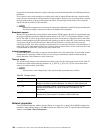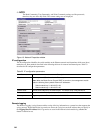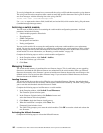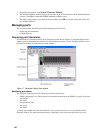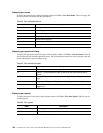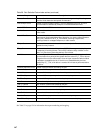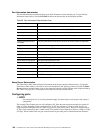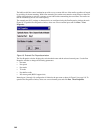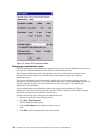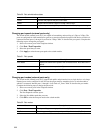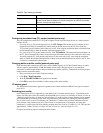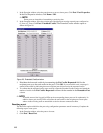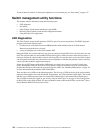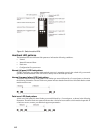
108 Intel Blade Server Fibre Channel Switch Module SBCEFCSW / FC Expansion Card SBFCM Guide
Port Information data window
The Port Information data window displays port detail information for the selected port. To open the Port
Information data window, click the Port Info tab below the data window in the Faceplate window.
Name Server Data window
The Name Server Data window displays information about the port and the connected device. To open the
Name Server Data window, select one or more switch modules in the Topology window and click the Name
Server tab below the data window. You can also open the Name Server Data window in the Faceplate window.
See Table 19 on page 93 for a description of the Name Server Data window entries.
Configuring ports
✏ NOTE
For external ports (0, 15), all port parameters apply. For internal ports, only the port state setting is
configurable.
The external Fibre Channel ports are self-configuring GL_Ports that auto-negotiate transmission speeds of 1
Gbps or 2 Gbps depending on the connected device. A GL_Port connects to a loop of public devices or a
single device and configures itself as a fabric loop port (FL_Port), fabric port (F_Port), or an expansion port
(E_Port). Each external port has 12 buffer credits. This enables a cable length up to 20 km at 1 Gbps or 10 km
at 2 Gbps. Eleven credits from one port can be borrowed by the other port to extend transmission distances.
Table 29. Port Information Data window entries
Entry Description
Port Address Port Fibre Channel address.
Administrative Port Mode The current administrative port mode: GL, G, FL, F, TL.
Operational Port Mode The operational port mode.
Administrative Port State The current administrative port state: online, offline, diagnostics, or down.
Operational Port State The operational port state.
Configured Administrative
Port State
The port administrative state that is stored in the switch module configuration.
Logged In Indicates whether logged in or not.
E Port Connection Status Indicates whether the E_Port connection is enabled.
E Port Isolation Reason Indicates why the E_Port is isolated.
MFS Mode Port tuning indicator.
I/O Stream Guard Whether RSCN suppression is enabled or disabled.
Administrative Port Speed The speed requested by the user.
Operational Port Speed The speed actually used by the port.
TLMode Indicates if TL target or TL initiator is used.
BB Credits Indicates whether the buffer-to-buffer credits are set.
Ext Credits Requested Indicates whether the extended credits are requested for ports.
Medium The SFP module type.



